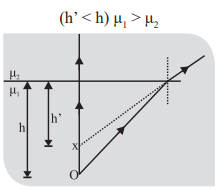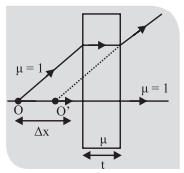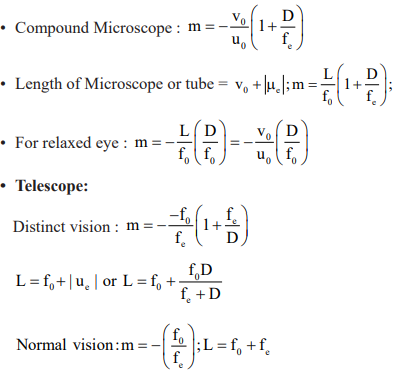Hi CUET aspirants, Welcome to Amans Maths Blogs (AMBIPi). In this post, you will get CUET Physics Notes Ray Optics and Optical Instruments AMBIPi. This CUET Physics Notes are designed by analyzing to the CUET Syllabus and CUET Previous Years Questions Papers.
CUET Physics Notes
CUET Physics Ray Optics and Optical Instruments: Important Points to Remember
There are following important points in this chapter of Ray Optics and Optical Instruments.
- If a mirror is turned through θ then the reflected ray turns through 2θ angle.
- A person with a velocity V moves towards a plane mirror then the image moves towards the person with velocity 2V.
- A medium with higher refractive index is said to be optically denser index.
- Critical angle of water and diamond are 48.750 and 24.400 respectively.
- In total internal reflection, there is no loss of intensity because 100% of incident light is reflected back into the same medium but with mirror or lens loss of intensity is found.
- Optical fibres used in transmission and reception of electrical signal are used by converting them first into light signals.
- In case of thick lens focal length depends upon whether one or the other surface faces the incident light.
- Real images form on the side of lens that is opposite to the object and virtual images form on the side.
- If the lenses of focal lengths f1 & f2 are separated by a finite distance d, the focal length F of the equivalent lens is given by
-
When lens is immersed in a liquid or medium its focal length always increase but nature of lens changes which is as (i) no > nm = nature remains same (ii) no < nm = nature becomes opposite (iii) no = nm = lens disappear
- When refracting angle of prism is small (100), the deviation ẟ is calculated from the relation ẟ = (µ–1)A.
- For prism with bigger refracting angles the deviation is calculated from ẟ = (i1 + i2 ) – A.
- Primary rainbow is more bright than secondary rainbow.
- There is no dispersion of light refracted through a rectangular glass slab but lateral displacement occurs.
- In lateral displacement, there is no overlapping of colour is called a pure spectrum.
- Back of observer must be towards the sun is the essential condition for observing a rainbow.
- The distance between near point and far point of the eye is called Range of vision.
- For a child, near point may be as close as about 7 to 8 cm and for an old man, near point may be as far as 200 cm.
- In a telescope, aperture of objective lens made large to increase magnifying power and resolving power of the telescope.
- The largest reflecting telescope in India has a diameter of 2.34 m. It is being maintained by Indian Institute of Astro
Physics, Bangalore. - Images formed by mirror do not show chromatic aberration.
- If a lens is made of several materials. Number of Materials = Number of Images
CUET Physics Ray Optics and Optical Instruments: Important Graphs
1. The graph of 1/u versus 1/v for a concave mirror, if real image is formed.

2. The graph shows variation of v with change in u for a mirror.
3. The graph between angle of deviation (δ) and angle of incidence (i) for a triangular prism is represented by
4. Refraction through parallel slab Emergent ray is parallel to the incident ray, if medium is same on both sides.
Note: Emergent ray will not be parallel to the incident ray if the medium on both the sides are different.
5. Apparent depth of submerged object
For near normal incidence .
Note: h and h’ are always measured from surface.
Note: Shift is always in direction of incidence ray.
6. Critical angle & total internal reflection (TIR)
CUET Physics Ray Optics and Optical Instruments: Important Formulas
1. Introduction, Reflection of Light, Plane Mirror
2. Spherical Mirror
3. Refraction of Light, Apparent Depth, Shift, TIR

4. Prism
5. Refraction From Curved Surface, Lenses
6. Optical Instrument: Human Eye, Simple Microscope
7. Compound Microscope, Telescope
CUET Physics Mock Test
Now, you have revised the this CUET Physics chapter. So, you must need to practice CUET Physics Sample Papers. By solving these CUET Physics questions, you will be more confident about your CUET preparations.


















